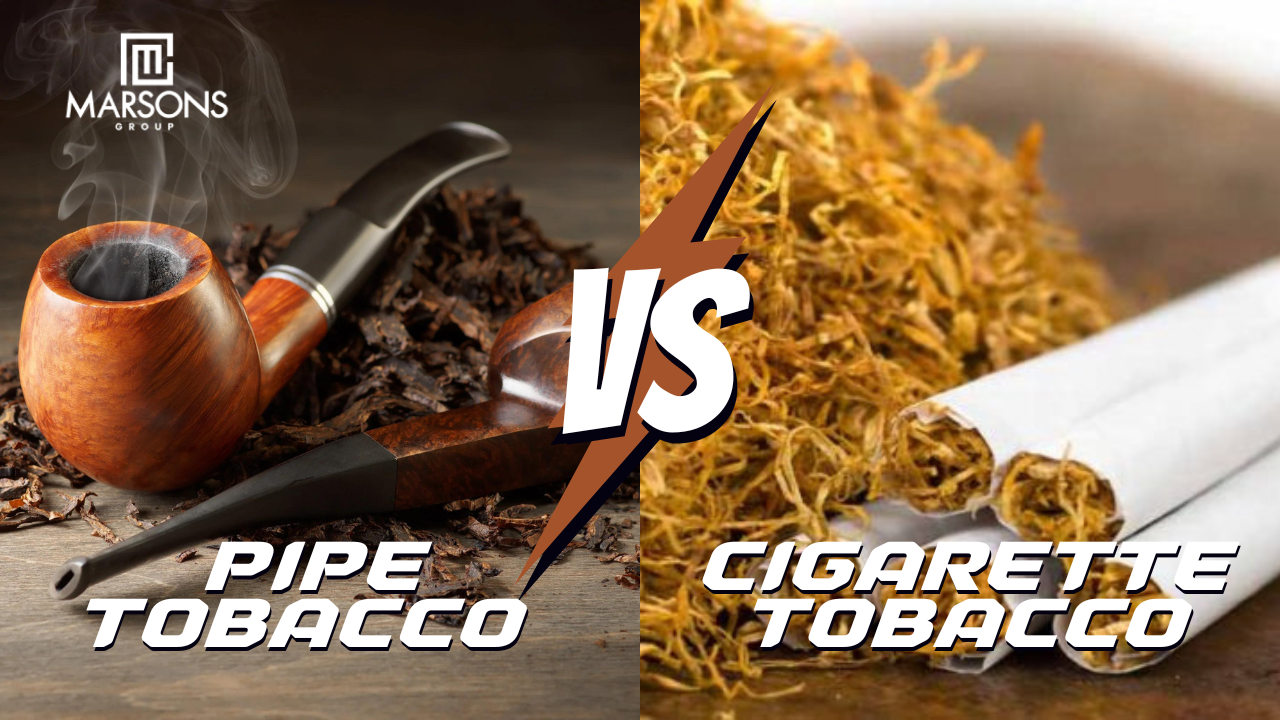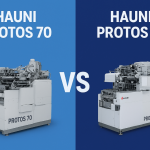When it comes to smoking, the choice between pipe tobacco and cigarette tobacco often boils down to personal preferences, availability, and a smoker’s experience. While they both serve as the basis for smoking, pipe tobacco, and cigarette tobacco are distinctly different, not only in terms of composition but also in terms of how they are processed and enjoyed and their cultural significance.
In this article, we’ll explore the differences between pipe and cigarette tobacco, exploring their unique characteristics, production methods, smoking experiences, and more. By the end, you’ll have a clearer understanding of what sets these two forms of tobacco apart and why some smokers prefer one over the other.
Types of Tobacco Leaves Used
The primary difference between pipe and cigarette tobacco is the type of tobacco leaves used.
Cigarette Tobacco:
Cigarette tobacco is typically made from a blend of Virginia, Burley, and Oriental tobaccos. These types of leaves are cured in different ways, and the blend is designed to burn quickly, which suits the fast, convenient nature of cigarette smoking. Virginia tobacco is high in sugar and provides a smooth and sweet flavor, while Burley tobacco is more robust and nutty. Oriental tobacco adds complexity with its slightly spicy and aromatic qualities. Together, they create the signature cigarette taste.
Pipe Tobacco:
Pipe tobacco, on the other hand, often comes from a wider variety of leaf types and tends to be of higher quality than cigarette tobacco. Common types of tobacco used for pipes include Latakia, Perique, Virginia, Burley, and Cavendish. The diversity of these leaves offers pipe smokers a more complex flavor profile, which is one of the primary attractions of pipe smoking. For instance, Latakia adds a rich, smoky flavor, while Perique is spicy and strong, giving depth to the smoking experience. Pipe tobacco also tends to be cured and aged for extended periods, allowing for a more sophisticated taste.
Cut and Preparation
The physical preparation of the tobacco is another significant difference between pipe and cigarette tobacco.
Cigarette Tobacco:
Cigarette tobacco is typically finely shredded and cut into small, uniform pieces. This helps cigarettes burn evenly and consistently. The fine cut also allows cigarette smokers to inhale more efficiently, which contributes to the quick and more intense nicotine absorption associated with cigarette smoking. The cut is designed for machine-rolled cigarettes, focusing on convenience and speed.
Pipe Tobacco:
Pipe tobacco, in contrast, comes in various cuts, such as ribbon cut, flake, plug, and twist. These cuts are much more extensive and more varied than cigarette tobacco, which results in a slower burn and a more extended smoking session. Cut diversity offers different smoking experiences, from the leisurely and slow-burning flakes to the more compact and flavorful plugs. Pipe smokers often enjoy the ritual of preparing their tobacco, as it allows them to customize their smoking experience, controlling the burn and flavor intensity.
Additives and Flavorings
Both pipe tobacco and cigarette tobacco often contain additives, but the types and purposes of these additives vary.
Cigarette Tobacco:
Modern cigarette tobacco typically contains numerous additives. Some of these additives enhance the flavor of the tobacco, while others control the burn rate. Cigarette companies often add chemicals such as ammonia to increase nicotine absorption, making cigarettes more addictive. Flavor additives like menthol may also be added to mask the harshness of the smoke. Due to the high volume of additives, cigarettes can have a somewhat synthetic taste compared to pipe tobacco.
Pipe Tobacco:
Pipe tobacco, while sometimes flavored, generally contains fewer additives than cigarette tobacco. The flavorings in pipe tobacco are often natural, with many tobaccos flavored using fruit, vanilla, rum, or whiskey. Cavendish tobacco, for example, is usually treated with natural flavorings to create a sweet, aromatic smoke. Pipe tobacco is typically appreciated for its nuanced, natural flavors, with many blends left unflavored to let the inherent characteristics of the tobacco leaves shine through.
Nicotine Content
Another significant difference between pipe tobacco and cigarette tobacco is the nicotine content.
Cigarette Tobacco:
Cigarettes are designed to deliver nicotine quickly and efficiently. Cigarette tobacco, because it is finely cut and contains various additives, allows for a rapid absorption of nicotine into the bloodstream. This fast delivery makes cigarettes particularly addictive. The nicotine level in cigarettes is often consistent, as commercial cigarettes are manufactured to ensure a controlled nicotine delivery per cigarette.
Pipe Tobacco:
Pipe smoking, by contrast, involves a much slower nicotine absorption process. The more significant cut of the tobacco and the absence of particular chemical additives means that nicotine is absorbed more slowly. This leads to a more relaxed smoking experience that lasts longer. Many pipe smokers don’t even inhale the smoke deeply into their lungs, further reducing the intensity of the nicotine hit. However, the nicotine content in pipe tobacco can vary greatly depending on the type of leaves used and how the tobacco is cured.
Smoking Method and Inhalation
The way pipe and cigarette tobacco are smoked differs significantly, affecting both the smoking experience and the health impacts.
Cigarette Smoking:
Cigarettes are typically smoked quickly and inhaled deeply into the lungs. This inhalation method allows smokers to absorb a significant amount of nicotine in a short period, contributing to the more immediate effects of cigarette smoking. The inhalation of cigarette smoke is also one of the main reasons for the high health risks associated with cigarette use, as it exposes the lungs to tar and other harmful chemicals.
Pipe Smoking:
Pipe smoking is a much more leisurely activity, and pipe smokers typically do not inhale the smoke into their lungs. Instead, they “sip” the smoke, savoring the flavor in their mouths before exhaling. This method of smoking is less harsh on the lungs and may reduce the risk of certain health issues, although pipe smoking is not without its risks, particularly concerning cancers of the mouth, tongue, and throat. The lack of deep inhalation also means that the nicotine is absorbed more slowly, contributing to the more relaxed nature of pipe smoking.
Burn Rate and Smoking Duration
The burn rate and overall duration of a smoking session differ markedly between cigarette tobacco and pipe tobacco.
Cigarette Tobacco:
Cigarette tobacco is designed to burn quickly, allowing for a short and efficient smoking experience. The fine cut of the tobacco, along with the additives that promote a faster burn, means that a typical cigarette can be smoked in just a few minutes. This fast burn rate suits those who prefer quick smoke breaks or need a rapid nicotine fix.
Pipe Tobacco:
Pipe tobacco burns at a much slower rate than cigarette tobacco. The more significant cuts and lack of particular chemical additives contribute to a longer-lasting smoking experience. A single pipe bowl can take 30 minutes or more to smoke, providing a more contemplative and relaxing session. This slow burn is part of the appeal for pipe smokers, who often enjoy the ritual of packing their pipe, lighting it, and then savoring the smoke over a more extended period.
Health Risks
Both cigarette and pipe smoking carry health risks, but the extent and nature of these risks can vary depending on the smoking method and the type of tobacco used.
Cigarette Smoking:
- Cigarette smoking exposes the lungs to thousands of harmful chemicals, including tar, carbon monoxide, and carcinogens.
- It is a leading cause of lung cancer, heart disease, stroke, and respiratory illnesses.
- The deep inhalation of cigarette smoke allows these harmful chemicals to penetrate deep into the lungs, causing significant damage over time.
Pipe Smoking:
- Pipe smoking may be less harmful than cigarette smoking due to the lack of deep inhalation by most pipe smokers.
- Pipe smokers are still at risk for mouth, throat, esophagus, and tongue cancers, especially if smoking flavored or heavily treated pipe tobacco.
- The health risks are higher for pipe smokers who inhale the smoke, though this is less common.
Cultural Significance and Traditions
Finally, the cultural and historical context surrounding pipe and cigarette smoking plays a role in their perceived differences.
Cigarettes:
- Cigarettes are associated with convenience, modernity, and addiction.
- The 20th-century rise in cigarette smoking was fueled by mass production and aggressive marketing.
- Cigarettes have become a symbol of modern consumer culture.
- Smoking cigarettes is often a quick activity, usually done in social settings or during quick breaks, with less focus on ritual or tradition.
Pipes:
- Pipe smoking is viewed as a traditional, more contemplative, and refined activity.
- It is often associated with intellectualism, relaxation, and craftsmanship.
- Pipe smokers enjoy the ritual of preparing a pipe, choosing a tobacco blend, and savoring the slow smoking process.
- With a history that spans centuries, pipe smoking remains a niche but cherished practice among enthusiasts.
Conclusion
The difference between pipe tobacco and cigarette tobacco goes far beyond mere preference. From the types of leaves used to the smoking experience, nicotine delivery, health risks, and cultural significance, these two forms of tobacco cater to vastly different tastes and lifestyles. Cigarette smoking offers a quick and potent nicotine fix, while pipe smoking provides a more leisurely and flavorful experience. Each has its characteristics, benefits, and drawbacks, making the choice largely a matter of personal preference and lifestyle.
Understanding the nuances of pipe and cigarette tobacco can help smokers make informed decisions about their habits while also appreciating the rich history and tradition behind each form of smoking.





